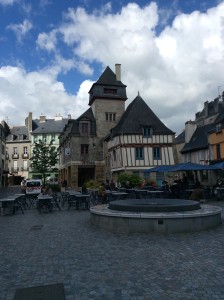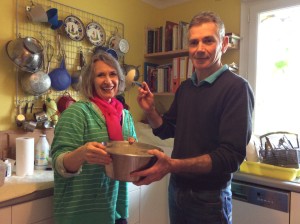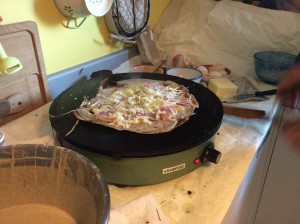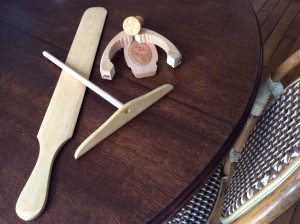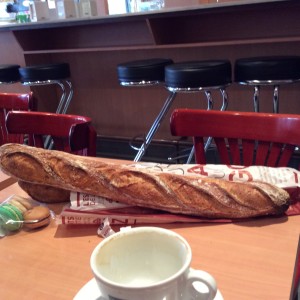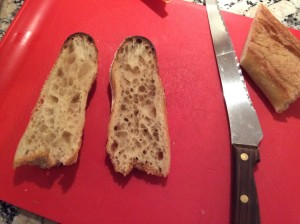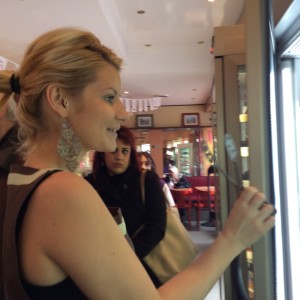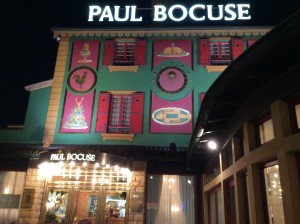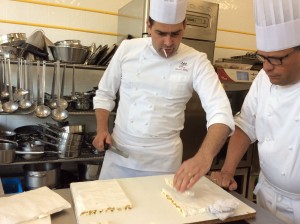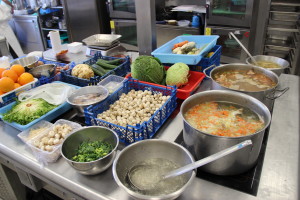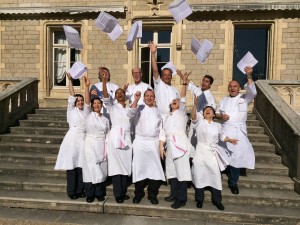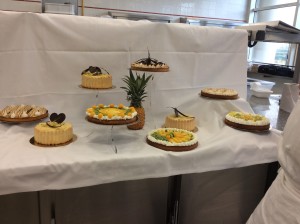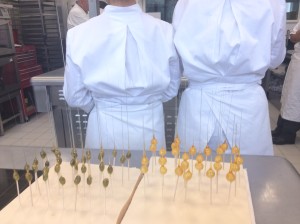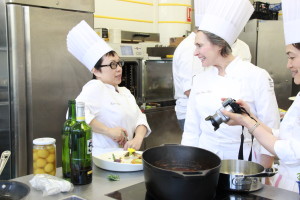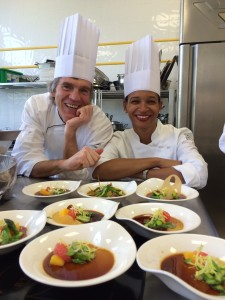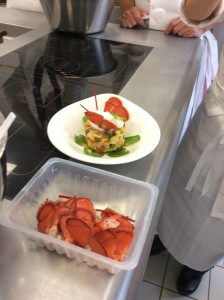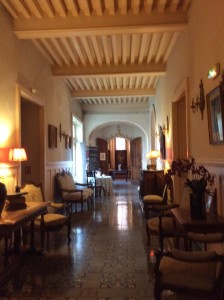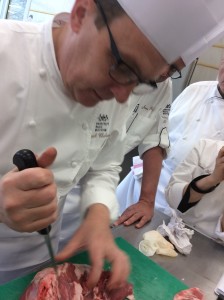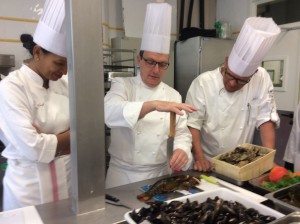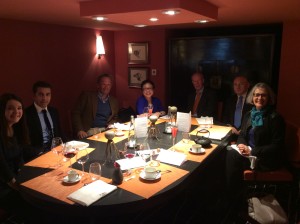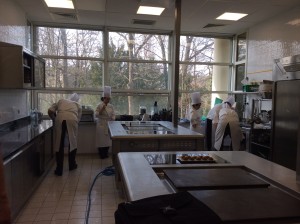The sabbatical has been great. Thank you for participating with me. Now we’re heading home, rested, ready to be back with our beloved friends and to get to work. My new book (not an Unbinding one, something very different!) is coming together in my head. So I’m going to go quiet for a while to write. So grateful for each one of you who has been part of my sabbatical. I’m excited about Next Steps!
Category Archives: Cooking
Cooking in Brittany
I’m on the train, traveling back to Paris through the gorgeous Breton (Brittany) countryside (green, green, hilly). It’s a cloudless day.
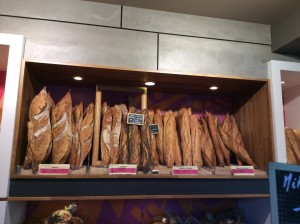
MY baguette was from the far right – ‘Pain de patron.” The little local bakery appeared on a list of the 111 best patisseries in France. Here are their eclairs.
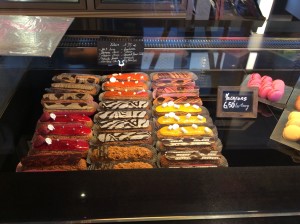
The Plomblin bakery’s eclairs. This is a town of about 4,000 – sprawling through the aid countryside. these eclairs would leave most Paris bakeries in the dust.
I’m munching in a leisurely way on a ham sandwich made with salt-chipped, Breton “flour de sel” butter and the most exquisite multi-grain baguette composed of what my friend Patty Feld would call bark and twigs and crunchy bits. Life is great. I’ll probably have to search out a bottle of water from the bar pretty soon. I have loved the last week with my friend Judy and her French husband Marcel. Judy and I went to high scool together and she has been one of the inspirations and cheerleaders for my learning French. She’s an international dealer Quimper pottery (www.BrittanyByways.com and www.thequimpercollection.com). I sent her an e-mail six months ago and told her my plans for my trip to France. She whipped back a response three days later announcing that she had it all arranged:
- I was coming to Brittany for a week to stay with her and Marcel.
- I was going to have a lesson in making kouign amann (a round of something like croissant dough layered with a horiffic amount of butter and sugar – it caramelizes) with the head patissier in the Quimper bakery,
- I would work a day in the loveliest restaurant in Quimper, The Priore (www.le-prieure.fr),
- and Michel, their neighbor who makes traditional, Breton buckwheat crepes in Quimper would give me an evening lesson. It was all arranged.
Didn’t seem to be any point of arguing, and it sounded great so that’s what I did. My only contribution to the plan was to ensure that my trip to cook with the hot shots in Brittany was at the END of the trip so that I could minimize humiliation by (a) my cooking, and (b) my French. Last Sunday, I headed to the Montparnasse station to catch the train to Bretagne. Two hours before that, I had put other dear high school friends onto a train to go horseback riding in some wilds I haven’t seen between Paris and Burgundy. Ellen and Mary and I had had two glorious days visiting the Rodin museum, the Paris islands, the outside of Notre Dame (too crowded), cooking a dinner here, and eating in the most wonderful restaurant so far, Stephane Martin, a brilliant young chef who’s cooking in the 15th arrondissement, 67 rue des Entrepreneurs (www.StephaneMartin.com). If you’re in Paris, bag Napoleon’s tomb – get to Stephane Martin. Brittany is remote – it’s a four and a half hour fast train ride from Paris to the northwest.

Brittany’s green. (It’s the NW part of France, called “Bretagne” in French, and it’s why after the Norman Conquest (1066), the land to the north is called “Great Britain.”)
You know about Normandy, if only because of the Normandy beaches and D-Day. Normany is famous for cows and Camembert and apples and crème and Calvados. Brittany is famous for butter and carmel and strawberries and oysters and fishing villages and langoustines and Quimper pottery. If you’ve had salty carmel ice cream lately, or pieces of rocky salt on a carmel, it’s an import from Brittany. It took 7 hours of train riding to get there until fairly recently. It’s far, wild and charming. It’s not the Eifel Tower. It’s rural.
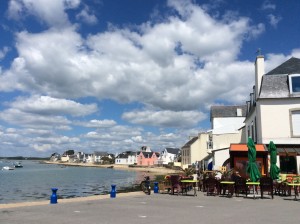
Here’s a little fishing village 5 miles from Judy and Marcell’s house. We ate lunch there. The pink house was built for fishermen to hang out in during the winter (wholesome activities, not so much with the drinking).
The weather is like Seattle’s – humid, an acidic-soiled microclimate that’s mild in the winter and cool in the summer. There are banana palms, cacti, fig trees, fishing villages with green and blue shutters, boats all over the place and loads of tourists all summer. It’s quiet now. The professional cooking deals that Judy had arranged scared the andouillete out of me. This is very French, high level cooking, way out of my league, only available because Judy has been in business here for about 20 years. She knows everyone and they love her. I don’t like fumbling about. I really didn’t want to fumble around on Judy’s ticket. Eesch. One of my friends interviews for jobs well, and worries that she may be an articulate incompetent. I get it. But I sucked it up and stepped into:
Challenge #1, The Bakery and kouign amann, on Monday morning (www.biscuiteriedequimper.com). No pictures of any of this stuff. This isn’t personal. It’s business. You can’t act like a tourist on a job. Two guys were whipping huge baking sheets of dough onto stainless steel counters with, oh horrors, an enormous picture window so the busloads of tourist clients could see exactly what I was doing. They gave me a white shirt with too-large buttons that fastened at glacial speed, and an enormous apron.
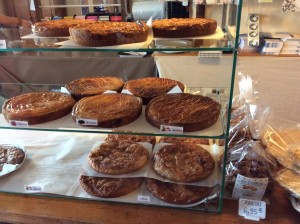
Breton butter cake (“Kuighn amman”). No action shots, but the middle row is part of the 100 left from yesterday’s baking.
The head baker gestured to the table next to him, handed me a massive hunk of fragile dough, a cold square of about 3 pounds of butter and a thick, meter-long wooden rolling pin. He picked up his pin and we started, with me trying to mimic his effortless motions as closely as possible. (I felt exactly like that time I decided to start ballet in law school. The teacher had been a principal dancer with the NYC Ballet, under Ballanchine. I was awed, and behind the curve.) I tapped the top of the dough, tapped the bottom, stretched out flaps on the sides, folded them in, rolled the whole deal out to a meter and a half, and a meter wide, maybe, then folded it like a letter, flicked on flour. (At least I can do the folding and the flour flipping well – that’s one of the deals that separates les professionels from les amateurs, I’m here to tell you.) But the real breaking point hits at stage #4. You roll out the now 750+ layers of dough and butter and sugar to two meters long and a meter wide (3+ feet x 6+ feet). I could barely reach the back of the stainless steel table, but did it without ”dechire”ing (tearing) the dough. That was a miracle. A hole in the dough would have been “une catastrophe.” We did it – went through the whole six step process four times and then he gave me a taste of a finished one. as I struggled to UNDO the buttons quickly, which were still larger than the holes. The kouign amann was staggeringly good, if you like crispy pastry, butter and crispy carmelized sugar. I do. It was a Meg Ryan/Billy Crystal-in-the-diner moment, I’m here to tell you. But I was in France. I was trying not to act like an amateur, so I was subtle and didn’t embarrass anyone. When we do the closest approximation of kouign amann of which I’m capable at our house in MN, I’m thinking some of you may not be capable of pulling off my sophisticated restraint. I’m putting $5 on Karen who-shall-remain-last–nameless moaning and pounding on the table.
Challenge #2, Le Priore (the Priory), Tuesday all day: It’s a gorgeous place – the12th century priory (de-priory-ized during the French revolution – a bad time for the church in France – then used as a military depot, then restored during the late 19th century, then further restored and used as the loveliest restaurant in Quimper fairly recently. The last party Judy arranged there was for the American Ambassador and visiting dignitaries. Restaurants are usually closed on Monday, so Tuesday is really the first day of the work week for them. Fish arrive, they make stocks from langoustine shells, they organize and get things underway for the week on Tuesdays. Judy and I went in through the back door of Le Prieure (www.le-prieure.fr) . It was more disconcerting than walking in the front. The sous-chef (the chef in charge of the kitchen, the #2 guy, not the planning/oversight chef), smiled reassuringly at my mommy surrogate, gently pried my hand from her arm, showed me the locker room where I could stash my raincoat and pink My Little Pony lunch box (okay, I’m getting hyperbolic here), didn’t introduce me to the other kids, but did give me an apron to wear over my plain black clothes, handed me a knife and something like 150 of the biggest, most gorgeous langoustines I’d ever seen. They were alive, iced, and thank heavens I, child of Ohio, knew all about twisting off their little torsos from their tails. I got to it. I murdered all of them. I know I’m going to come back as a grasshopper in my next life. Or a langoustine. The young guy next to me (Christophe) showed me how they wanted them shelled. You pinch the shells together on the back (“tack, tack”), then delicately pull off each shell segment except the last two and the tail. Okay, I could do that. The shells poke your hands, but I’m fast. And Christophe, a sweetheart, kept handing me spoons of things to taste – fish tartare with lime, smoked Norwegian salmon. Total sweetheart.
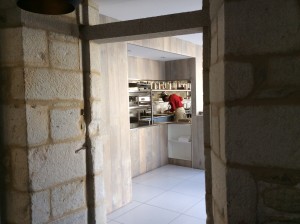
The only photo I took, as I was leaving – here’s Christophe. If he’d been plating, his head would have been 12″ lower.
All this time, waiters and the chef de cuisine and other kitchen help arrived, held out their hands to shake (I offered a wrist, not wanting to slime them with my gooey, seafooded hands. They murmured “bonjour,” shook my wrist, kissed me on both cheeks, then told me their names. I smiled, said, “Marte,” and continued shelling crustaceans, which I lined up in military precision in a big metal pan. Other than the one female langoustine with a HUGE roe sack that disintegrated between my fingers, it went well. I pointed my humiliating failure out to the sous chef when he came by (there was no checking to see that I was doing things well – they just told me what to do and disappeared), he said, “pas de probreme,” and chucked it in with the others. I said, “Pas de problem ? C’etait une catastrophe !” He laughed and bolted. I finished.
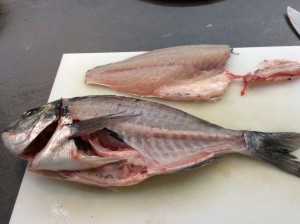
I filleted this with six cuts per side. I’m proud. I don’t need to hang my head in shame before the numerous fisherpeople of Minnesota.
He waved me toward a pile of dorade (lovely, medium sized fish – “dolphins” in English, but not the mammals). A huge pile of dorade, something like 60 of them and asked me whether I wanted to fillet them. Now the secret is that I CAN fillet dorade. I learned how here, since Russ does the fish in our family. The first time I filleted a fish at L’Ecole Alain Ducasse, the chef inquired politely if I were making tartare. But by the third one, I had nailed it. So the chef and I tackled the dorade. We fell into a rhythm. He filled them, I deboned them with lightening speed. You do it by feel. We whipped through the enormous piles of dorade, then I finished and did everything on the huge, slithery cod fish, but only 3 of those. Then I washed two huge sacks of mussels – 5 kilos/11 pounds each – and we had lunch before the service. The cooks and the waiters were all kids in their 20s, except for the chef. Christophe and I had progressed from “vous” to “tu” (I was thrilled that he wasn’t calling me “madam,” but was telling me what to do as if I could do it. Otherwise, no one had talked with me all morning (except for (“pardon,” “chaud” [hot], nods and all the kissing), so I’d kept my head down, smiled occasionally and worked. Lunch was simple and absolutely delicious – zucchini and the loveliest roast chicken you’ve ever tasted. I asked later – Christophe had made it. Here’s the recipe. (1) get a bunch of French chicken legs and thighs (unseparated). Put on onion, salt, pepper, olive oil, garlic and un petit peu de beurre (“a little bit of butter,” and you have to say that with a French accent or it doesn’t brown correctly). You probably brown it first in the butter, then put it in the oven at 180 degrees (about 370 F) for about 30 minutes. It has to be a French chicken, which are more chickeny than ours, as Julia Child says. Nobody talked to me, so I just smiled, ate quickly and we all raced back to work.
They were now ready for the lunch service – show time. I gave serious thought to hanging myself up on a corner hook by my apron strings to be out of the way. It was like being backstage in a play opening night without having attended rehearsals. No quiet corner appeared. The sous chef gestured to me as he started to unstop the huge sink. French sinks don’t have drain baskets – anything thrown into them either plugs up the drain, or is stopped by four little crossbars and plugs up the sink. Six gallons of scaly, scary gray water shimmered in that sink. The cooking chef fished his hand down to find the drain and told me he’d explain what he wanted me to do as soon as he fixed this. “Chef, go away and cook. I’m highly skilled in the exact technique for doing this.” Turned out I’d just flipped the magic switch. Ten minutes of fishing fish scales and guts out of opaque liquid with bare hands and I was part of the team. A slightly moody young cook ran past, shifted the trash can to right next to me and grinned. I helped people do things, then I got to make 80 cheese-and-leek filled chou pastry hors d’oeuvres with tiny pastry hats. Fairly snappy pastry bag and balancing work. And at 2:00 everyone left until 6:00. The executive chef had left it up in the air as to how long I was supposed to stay. They asked if I wanted to come back after lunch. Score! I asked if they needed me, because I really didn’t want to be in the way of “le service” [the dinner service], and they said, no, I would be useful. Yes! Invisible high five.
I walked around Quimper for four hours. I explored the medieval town, bought some macarons from the pastry shop of a MOF (the best artisan in France award). It’s part of my education to taste things. I walked by the river. I walked up hills.
I sat in the cathedral for a while, strolled through the medievally-inspired Priory garden behind the restaurant, across from the Quimper faience museum (very fun), then went back to work. It was great. We prepared a huge buffet for 50 – millions of hors d’ouvres that Christophe and I arranged on platters, I stuffed puff pastry vol-au-vents with mushroom duxelles, toped them with an elegant triangle of foie gras, heated them and garnished with cilantro. I spun into the rushing dance down the narrow spaces between tables, carrying stuff back and forth from the specific places in the huge walk-in refrigerator room. I covered platters with film (plastic wrap. FRENCH plastic wrap that has no cutter strip on the box, you have to find a knife and try not to tangle it. It’s easier to bone the fish. But they let me onto the team, and I watched and when things calmed down, asked questions and helped different people and suggested platter arrangements. They can really, really cook. I learned ways to plate sausages decoratively, how to cook riz de veau (veal brain and it’s actually amazingly good). You cook it just like sole meuniere – brown it, then tilt the frying pan over a roaring flame and flip spoonsful of boiling butter over it. I earned an “impeccable” from Christophe, over a plating suggestions to keep the darned chou pastry appetizers from rolling all over the place. That may be the height of my career. He’s young, but the guy does the most gorgeous plating you’ve ever seen. He should teach when he’s older – he’s gifted. I also hope he started standing up straight when he’s working rather than leaning over nearly double. His 50 year old back would thank him.
They started making jokes with me. The young riz de veau guy who cooks well and moved the trash can for me (probably is the one who plugged up the sink), rushed over to me, grinning, as I shelled 20 pounds of cooked mussels – held up a beautiful, white-tipped, elongated French radish (pronounced, “rad-ee”) and said, “Marte, are you rad-ee??” It was a joke! Mikey likes it! Christophe created a particularly beautiful plate. I ventured my first English, grinning, “Nice!” They asked what it meant. I made the French sideways hand shake as if you’re flicking water off the ends of your fingers (it’s along the lines of, “wow, will you take a load of that – pretty snappy.”) So “nice” became the big word of the evening when anyone had a moment to talk. We worked on high fives before I went home that night. Someone probably told them to be nice to their visiting aunt that morning. They did it. Then they let me into the family. So if you’re ever in Quimper. THAT’s the place to go for an exquisite meal. Le Priore.
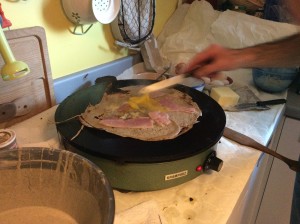
Making a crepe (a “galette,” the Breton name), made entirely with buckwheat. See how thin it is? This one has ham and egg.
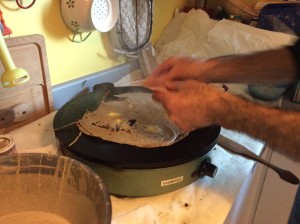 Challenge #3: the Great Breton Crepe Evening Wednesday. It was GREAT. Michel learned tho make crepes from his grandparents. His grandfather made his wooden spatula for him. You’ll see the pictures – what you can’t see is that these are the best crepes in the world. They’re way better than the Parisian ones made with white flour. These are buckwheat. I had them in Lyon last year and that one was no where NEAR as good as Michel’s. I’ve talked too long, so I’ll summarize and you look at the pictures. 1. You mix the batter by hand for a long time. I mean WITH your hand, not a spoon. It’s a little like splashing in mud, but loads of aeration. It takes a while – 3 eggs into a well of 500 grams of buckwheat flour, then add trickles of liquid. He eventually incorporated not quite a quart of milk (less than a liter bottle), 2 teaspoons of fleur de sel (that’s really approximate – it was bits in the hand 4 times), and maybe ½ – ¾ cup of water. You sweep tiny bits of flour from the edges of the egg mixture so that you don’t get lumps, then pull up streams of batter 18″ over the surface and let it cascade back into the bowl to aerate it. Then you cook them over a 240 degree centigrade (455 degrees Farenheit) griddle. The test one (enough salt? Thin enough batter to have little holes through which you can see the griddle?) is “pour le chat.” [for the cat]. Just like pancakes.
Challenge #3: the Great Breton Crepe Evening Wednesday. It was GREAT. Michel learned tho make crepes from his grandparents. His grandfather made his wooden spatula for him. You’ll see the pictures – what you can’t see is that these are the best crepes in the world. They’re way better than the Parisian ones made with white flour. These are buckwheat. I had them in Lyon last year and that one was no where NEAR as good as Michel’s. I’ve talked too long, so I’ll summarize and you look at the pictures. 1. You mix the batter by hand for a long time. I mean WITH your hand, not a spoon. It’s a little like splashing in mud, but loads of aeration. It takes a while – 3 eggs into a well of 500 grams of buckwheat flour, then add trickles of liquid. He eventually incorporated not quite a quart of milk (less than a liter bottle), 2 teaspoons of fleur de sel (that’s really approximate – it was bits in the hand 4 times), and maybe ½ – ¾ cup of water. You sweep tiny bits of flour from the edges of the egg mixture so that you don’t get lumps, then pull up streams of batter 18″ over the surface and let it cascade back into the bowl to aerate it. Then you cook them over a 240 degree centigrade (455 degrees Farenheit) griddle. The test one (enough salt? Thin enough batter to have little holes through which you can see the griddle?) is “pour le chat.” [for the cat]. Just like pancakes.
2. They cook quite quickly (a minute and a half to two minutes or so if it’s just plain – this doesn’t count cooking fillings). You can eat them (“nature,” or naturally – strawberries without cream or sugar – just plain, are “nature”), but in Brittany, “nature” means with butter spread on the non-presentation side, which is how they get really crispy. The more butter, the crispier. I limited myself to about 2 teaspoons of butter on my nature crepe. Others are not so restrained. In more modern times, people have started adding other things. A “complet” has ham and egg and gruyere-type cheese. You can have the egg sort of scrambled, or sunny side up, and it’s cooked right on the lower side of the crepe.
3. Everyone eats exactly what they want. Immediately. You don’t wait, you just get your crepe, run to the table and expire with the exquisiteness of it all.
4. Meal crepes first, then dessert crepes. You could do sautéed apples with salty carmel sauce, chocolate sauce, ice cream inside, whatever.
5. The tricky part is spreading the batter. There’s a little flat paddle and people who know what they’re doing spread it very thinly – with little holes where the griddle shows throough – it is crispier that way. But the trick is only pulling the batter. The REAL trick I discovered after doing a few is to put the batter on the griddle off center. I’m right handed – I ladled on the one ladle-full of batter onto the upper left part of the griddle with my left hand. Then I swooped the paddle to the right and down in a half-circle, then I swooped the paddle to the left and down. Then you fix the holes. This is at high speed, because the thing is setting up and hardening as milliseconds pass. ![]()
Judy and I went to the wood guy at the market yesterday (Thursday) and I bought the turner and batter spreader. I fell in love with hand-carved wooden butter molds, so I got one of them, and two butter stamps. We are going to have fun parties when I get home! The galette instruments are made of boxwood, like the pegs of daughter Elizabeth’s violin. I think that’s a good omen. I’ll be practicing. Michel was playing the Mendelsson concerto with the ones his grandfather made for him.
Judy and Marcel – thank you more than I can express!
The Best Baguette in Paris
This is it. It’s the best baguette in Paris, or at least it’s the best baguette in Paris’ sister. I’m here to tell you that I’m not arguing with the judges. It was superb – cream-colored insides with beautiful air pockets to trap runny cheese or sauce, and a crust that was both crackling and tore when you pulled it apart. I drank a cafe au lait at a little tea table in the bakery and stared at it.
This baguette was made by 24 year old Anthony Teixeira, baker of Aux Delices du Palais, a boulangerie/patisserie at 60 Boulevard de Brune in the 14th arrondissement, Porte de Vanves metro stop. As you come up from the metro at the Blvd de Brune exit, continue straight in the direction you’re facing. The bakery is about 10 blocks down, on a corner on the right. Paris has an annual baguette contest. They were worried that baguettes were tasting like those in American supermarkets or at Breadsmith.
Sorry to be rude, but the combination of machinery, dry yeast and fast rising methods produces Wonder Bread, no matter how pretty the loaf. Taste was disappearing, even in France, so about 20 years ago, Paris started a competition, Le Grand Prix de la Baguette Parisienne. It’s a big deal.
One day a year, hundreds of bakers from all over Paris submit baguettes that have to be made in the traditional way with the traditional ingredients: flour, starter or yeast, salt and water. No sugars, no additives, no fixatives, no freezing, not too much salt, the right size – just “la baguette de tradition.” That, by the way, is what you have to ASK for even in artisenal bakeries in Paris, or you’ll get absolutely beautiful….. (wait for it….) Wonder Bread. Enter the boulangerie (bread store), say, “Bonjour, madam. J’aimerai une baguette de tradition, s’il vous plait.” [Get your baguette, pay her the 1 euro and 20 centimes, or 1 euro and 40 centimes in a very fancy neighborhood.] Merci beaucoup. Bon journee, madam.” (See how polite you are?)
The contest, The Great Parisienne Baguette Prize is a juried, blind tasting of hundreds of submitted baguettes. The winner receives the honor of supplying bread to the President’s Elysee Palace each morning for a year.
The 2014 Grand Prix award was unique – never before had the same bakery won. M. Teixeira’s father was the winner in 1998. M. Teixeira Pere’s win is the reason the bakery is called “Aux Delices du Palais” (“in the manner of the delights of the Palace”). The 1998 honor is emblazoned on the signs in front, on statements inside, and on the edge of the cake and tarte wrappers. With the 2014 win, I suspect they’ll redo their signage.
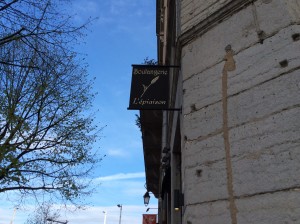
L’Epiaison, the great Lyon bakery – on the south side of the east-west street two blocks in front of the Vieux Lyon metro station, around the corner from the cathedral, and directly west of the Saone bridge over to Presque-Ile. THIS baker is my hero. Erica and Hiromi, my Paul Bocuse Institute cooking friends say it tastes like the best Japanese bread and they love it, too.
A word of explanation – I am as much of a baguette fanatic as exists in the United States. In the last couple of years, I’ve made well over 1000 baguettes in hand-made batches of 12. That’s a whole lot. I’ve experimented with various combinations of American flours, proportions, rising techniques, rising times, yeast/leaven combinations and baking temperatures. Our trip to France last January, with a nearly sign-language conversation in my five-month-Rosetta-Stone French with a brilliant Lyon boulanger spawned a fevered search to develop the perfect “levain liquid” (starter that isn’t normal, dry yeast).
I eat baguette every morning for breakfast, I ply the neighbors with it, Sandy, my buddy who delivers for UPS brings me 20 pound boxes of Bob’s Red Mill Organic White flour from Amazon and rumbles back down the forest driveway with baguettes tucked into the passenger seat. So I began the Paris leg of the Mad Baguette Pilgrimage last week. I headed to Aux Delices du Palais the first day I wasn’t in cooking classes.
I rode the metro to the south of the 14th arrondissement. I popped to the surface like a groundhog and spotted guys on the sidewalk selling 8 bananas and a pile of onions off of cardboard boxes at a very reasonable price. Maybe the food fell off a truck. A dad on a store stoop simultaneously watched an infant in a parked stroller, supervised his 4 year old on a scooter and smoked a joint. I, like the the groundhog, felt like diving back underground.
Now here’s the deal. If I wear my reading contacts, I can read my iPad, my computer, recipes and see the mushroom I’m turning, but subway stop diagrams and lower-shelf museum display explanations are muddy. If I wear my eagle-eye, long distance contacts, I can see the street signs in Paris. I was wearing my reading contacts. My iPad’s GPS was having a bad day. It showed the little dot that was me jumping lightly from block to block as I took five steps. I had no idea what direction I was headed. It wasn’t the neighborhood to be wearing your jewelry (I wasn’t), or flashing around an iPad. So, iPad in the purse clamped under my left arm, trying to look like a local (I didn’t), I strode boldly in a random direction, hoping to hell I was heading east on the Boulevard de Brune.
I had self-awareness of the Magoo-like quality of my activity over the next 12 minutes. Striking boldly into what was actually west on Boulevard de Brune, I marched under the over-pass, past a mattress with a covered, skeletal figure under a sheet. His shoes and hat were at the end of the mattress. I wondered if he had been raptured while the rest of us were attending to non-essentials like looking for baguettes. I skirted quickly past with firm tred, hoping a disembodied hand wouldn’t sneak out from under the sheet and snatch at my ankle the way my sister Sarah did that time in 3rd grade after I was fool enough to tell her I was afraid of someone grabbing me when I jumped into bed each night. There are some bad situations in life when you’re a victim, like car accidents and fires. But most of the time when you get into trouble, you’re just a volunteer. So I didn’t tell a soul what I was thinking.
The body under the sheet didn’t move. I did not tap on its shoulder to make sure it was alive. I walked two more blocks, sneaked another look at my iPad, no street signs being visible. I decided to head back toward the metro station and the guys selling bananas and onions, but to try the other side of the street. I turned left at a restaurant and discovered a seedy looking park with tulips braving blowing trash and the sign “Parque Auguste Renoir.” It was next to “Tabac Renoir” and “Brasserie Auguste Renoir.” Drawing quick deductions, I thought, “I’ll bet this has always been a dicey part of town. Most of the impressionists were poor, at least Van Gogh, but, well, except maybe Monet. Oh, yuck, look, there are absinthe drinkers at the Brasserie.” There were no well-heeled redheads with ruddy skin tones. Also, no baguettes.
So I headed back to the metro station, turned left and headed in the correct direction. 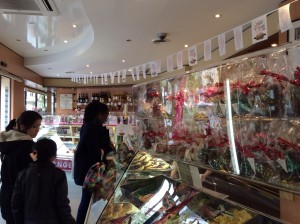 Ten quite respectable blocks later, I found Aux Delices du Palais. It was delightful. It was so normal. Easter candy sat on shelves, Little banner flags waved overhead, and, just like every bakery in Paris, baguettes stood in ranks against the wall behind the cash register.
Ten quite respectable blocks later, I found Aux Delices du Palais. It was delightful. It was so normal. Easter candy sat on shelves, Little banner flags waved overhead, and, just like every bakery in Paris, baguettes stood in ranks against the wall behind the cash register.
I waited in line with 3 ladies with headscarves holding children’s hands, 2 traditional looking French ladies and one man who carried shopping bags. When my turn came, the darling blond girl behind the counter (Madam Teixeira as it turned out), smiled and said, “Bonjour, madam.” I said Bonjour right back at her and told her I had come all the way from the United States to taste their famous and wonderful baguettes. “You have heard of us?” “Oui! You are famous for winning the Grand Prix de les baguettes de tradicion.”
So I got two baguettes and asked what else was very special that I should taste. She said that they had also won 4th prize in Paris for their macarons (the most famous French cookie – wildly chic and popular, so this is also a giant deal.) I asked for three of the little ones, which she had me pick out of the enormous case with 10 different flavors. Then she got my coffee, chilled my macarons in the quick freezer to make them perfect. The coffee was French coffee – this is not Italy. But after one bite, I understood what all the fuss is about macarons. That little, inch-wide, almond cookie with filling first crunched, then melted, then exploded with espresso flavor.
I tasted the baguette. It was stunning. I’m already envisioning the next round of experiments at home. I’m going to put more water in the dough, some subtle salt near the crust, a sprinkling of flour, and bake them browner. After a last conversation with Mme. Teixeira and many thanks, I left.
I stopped chez le fromager (at the cheese shop) in my neighborhood on my way home, clutching my baguettes. I fished euros out of my purse to pay for a little more Basque sheep’s cheese, gestured toward the baguette and asked my cheese guy, “Do you know what this is?” “Oh, madam, would you like me to put the baguettes into the sack with your cheese?” Ignoring the question: “THIS,” I said, “is the Grand Prix winner for the baguettes of 2014.”
“Oh-la-la-la-la,” he answered. “Who won? Where is the boulangerie?” I told him and asked if he’d like a taste. “Oh, oui, bien sur !” (of course!). I broke off a hunk and handed it to him. He grinned, turned his back on another customer who had just walked into the shop, and popped a bite into his mouth. “C’est formidable, eh? I will save the rest to share with my wife. You are very kind, madam.”
I smiled as I left, “It will go really well with cheese.””Oui,” he said. “Bien sur.”
End of an Era – Dinner at 3 Star Michelin Restaurant Paul Bocuse

Erica and I remembered that we are ladies and went out to dinner with Paul Bocuse. This restaurant has had 3 Michelin stars since 1965.
I’m on the train for Paris as we speak – the TGV, the fast train that like Lenin’s sealed train from Vienna to St. Petersburg, doesn’t stop and that goes straight from Lyon to Paris in two hours. This train zooms comfortably through a gorgeous day outside – about 65 degrees and sunny, and a Very Kind Man hauled my impossibly heavy bag onto the rack for me.
I tried to pack lightly and given the length of the trip, I really did. I brought the ends of bottles of shampoo, makeup, face soap, deodorant, contact solution, hairspray from St. Louis, then threw all of them and my smouldering brand-new hair dryer away this morning and will get new ones tonight in Paris after I get to the apartment. However, despite the fact that I gave away a bunch of the cooking equipment, two books, the striped chef’s pants, the clogs that weighed a good 6 pounds and the heavy backpack case they all came in, I STILL managed to collect more stuff. I stuffed in my aprons, four towels to hang on your belt, the two chefs ‘ jackets and of course a bunch of Lyonnaise silk mousseline scarves (they’re light, they’re small!) and the 5 pound Complete Paul Bocuse cookbook that 88 year old Paul Bocuse signed for me, “A Martha, Le bonheur est dans la cuisine [Happiness is in the kitchen, or in the cooking.] Paul Bocuse.” We didn’t get to meet him when we went to his restaurant and toured the beautiful kitchen and met the MOF who runs the kitchen. Chef Bocuse had a serious back operation this spring and is in a rehab center. And he still signed books for us. Very precious books.
We went to his restaurant on Thursday night – the night before our last day of cooking. It’s the only 3-star Michelin restaurant in Lyon and it feels very much like the way it was when Julia and Paul Child ate there. There is a wall of perhaps 8-10 murals in the courtyard as you enter the restaurant with great chefs and descriptions of them. The light was shining on my American heroes, James Beard and Julia Child, so the pictures didn’t come out. But Erica and I are here with Paul Bocuse and friends.
The Michelin star system is as brutal as the competition for the MOF (meillure ouvrier de France, see the entry “Polite and Practically Perfect, below).
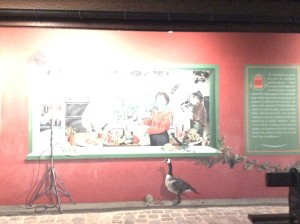
You can see the outlines of my heroes, Julia Child and James Beard in the Bocuse restaurant courtyard.
It’s a wildly rare honor to have one star, let alone three, and losing a star is horrific. A famous chef committed suicide several years ago after he lost a star and descended from three to two. The pressure is tremendous. The restaurants try to keep their presentation fresh, absolutely chic, creative, modern, with every detail compulsively perfect.
Stars add to bookings, stars add enormously to the amount restaurants can charge, stars add to the reputation of the chef. Three stars is the apex of the pyramid. Paul Bocuse has been given the [I think unprededented] honor of having three lifetime stars. The other example of amazing-in-the-star-department is next-generation chef Alain Ducasse, in whose school I’ll be studying for five days in Paris. Ducasse, also author of many cook books, is the only chef to have NINE Michelin stars concurrently – three each for three restaurants for which he’s chef de cuisine (one is the beautiful restaurant in the Eiffel Tower. He’s another culinary and PR genius.
But back to Paul Bocuse – it’s an old-fashioned restaurant, with the classic food, presentation, and ambiance. And it’s absolutely full. We went on Thursday night, and virtually every table was booked. Here’s my dessert:
We had dinner with the whole class and Chef Patrick – very fun. I had a beautiful lobster starter, then loup (sea bass) with a bernaise sauce flavored with a little tomato in a pastry crust. That was staggeringly good. Then cheeses, then dessert, then coffee. I kept imaging the Childs, and James Beard, and my grandparents eating the same food in the same room, laughing with friends over fabulous food – having a wonderful evening. It happened. It all happened.
Last days at L’Institut Paul Bocuse

Chef David assembling a franboise religeuse. We thought the pink little topknots (with real gold leaf on the forehead, a la halo) looked like Barbie Doll pink. Really, the German came up with that one.
What a beautiful last week. It was pastry week, with Chef David, head pastry chef for 12 years in a 3 star Michelin restaurant near Bresse, north of Lyon. (Remember? That’s where the best chickens in the world are raised.) We’d all been foundering with the staggering quantities of foie gras and truffles, but I’m here to tell you that a surfeit of sugar tasting is (a) a fun change, (b) strange.
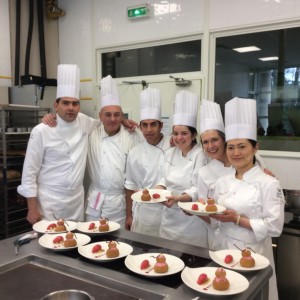
I was chef (head of the team) for the day we made the framboise religeuse. Here we are, David is the tall one. I’m taller than Hiromi.
You start craving salty things and protein and telling everybody NOT to make a plate for you of the framboise religeuses (“raspberry nuns”) or the tartes aux cinq chocolates. I was the chef in charge of a team of five making the lovely, creamy, raspberryish framboise religeuses, and the thought of eating a whole one after testing bits of the six component parts of that dessert all day was oppressive. Erica brought plates of salty crackers and Guiness beer cheese to cut the sugar the last two days. We were actually hungry for lunch for the first time since we got to L’Institut Paul Bocuse. Protein is a great thing. But sugar is incredibly fun to work with.
The oddest thing is that you shift ingredient palates. We’d been grabbing olive oil and salt and pepper, meat, fish and sauté pans with impunity for two weeks. (Parethetically, “pepper” is pronounced “paper” with a French accent.
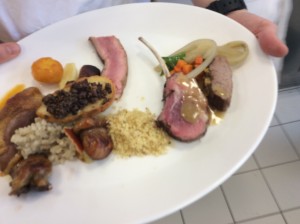
Or here – THIS is cuisine. That would be veal, lamb, beef, risotto with seafood and other various and assorted trifles.
The first week Chef Patrick asked (in English) for “paper” and I dashed to get him the roll of rough gray paper towels. He started laughing, put his hand on my shoulder and said, “I know my English is bad, but I want PAPER, white PAPER.” Oh,sorry, I laughed and went and got him a couple of sheets of the white parchment paper under the counter. He then led me by the arm to the salt and pepper by the windows. “Paper,” he said, “paper.”)
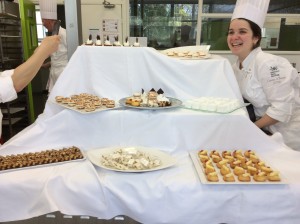
THIS would be pastry, and our darling Elodie, who some started calling our “baby chef.” How misleading! She can outlook almost everyone with one hand tied behind her back.
Anyway, we’d been developing great comfort with all the cuisine ingredients and the ways to cut and cook and slice and carve them. This week we’ve been in vanilla, pectin (did you know there are two kinds?), flour and fruit land. However, I can now report authoritatively that the constant in all French cooking, both cuisine and patisserie, is butter and cream. BUTTER and CREAM. In staggering quantities.
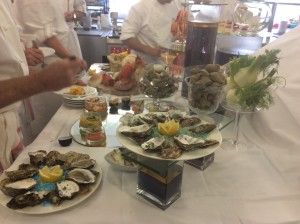
The next door neighbor class invited us to taste shrimp and oysters on Wednesday after I gave them our tray of little glasses of fancy desserts on Tuesday.
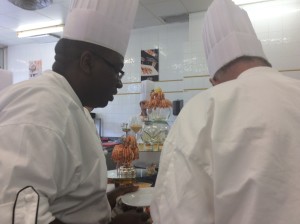
The other class. On the left is my friend from the Ivory Coast. He SMOKED the final test this week. Hotcha!
The other difference with doing pastry work rather than cuisine is that people stand outside our kitchen, elbows propped on window sills, eyeing you like starving children. I started making loads of friends when I noticed the voyeurs. I’d swoop over, scoop up a couple of macarons or little choux pastries, or tiny glasses of mousse-y things and would pass them out the door. Instant delight! I gave my box of a dozen little macarons to the receptionists at the hotel. (Macarons seem to be the most popular sweet thing in France. They’re almond cookies held together with different fillings. We made some with raspberry jam and chocolate hazelnut ganache on Wednesday.) I came downstairs 20 minutes later to put in a load of laundry and the receptionist was in the breakfast room, covering her mouth with her hand and chewing. She said they were the three best macarons she had ever tasted. Your stock is really high when you can impress is French woman with your cooking. Many try, few succeed. I’m here to tell you, that’s fun.
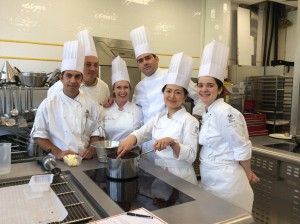
Here was our 6 component death by chocolate tarte with vanilla ice cream. It was really, really good.
So it has been a great week. David is a terrific teacher. We did classic creams and pastries and doughs and chocolate things enough times to really get a feel for the themes and variations. The class was beautifully structured, he had us all divide into teams and mis-en-place the ingredients (put them into little bowls and get everything organized and weighed), then we’d watch the team explain the process and make whatever it was we’d prepared, with David assisting. I can’t imagine him doing a better job of teaching. And oh, did I learn a lot. There are huge subtleties with pastry – exact quantities and really precise temperaturesand ways of stirring are paramount. The stuff is fragile.
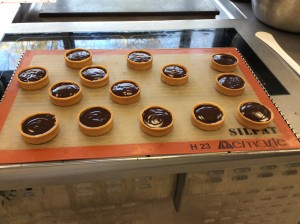
This is three components of a 6 component chocolate dessert (there’s a cookie on the tart, under the dark chocolate mousse. But look t those crusts!
My pastry dough is now really good – and I’ve learned the feel of working with it the right way – with the 90 degree angles of very thin pastry. That was worth the price of admission.
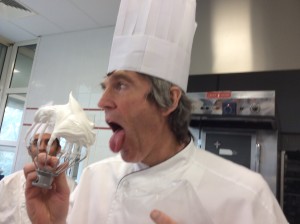
Raymond from Luxembourg didn’t seem to have the problem with sugar overload. He’s quite the chocolate guy and whipped cream worked for him, too. He kept running 15 kilometers after school, so things do even out.
I’m sorry we didn’t do boulangerie – bread and croissant making, which is what I know most about. It’s a completely different discipline in France than cuisine and patisserie, but I got to revisit my favorite baker in Lyon, who toured me through his kitchen last January and gave me his proportions, timings and the secrets of “levain liquid” (starter, but not to the sour degree of sourdough starter – quite a different taste).
It had been an incredible three weeks. I’m so grateful that I was able to do this first. It has given me a basis for all the rest of the cooking I’ll be doing. One of the greatest gifts of the time has been the new friends – our class was wonderful. We all spent this last week having that end of camp feeling. We’re done, and we did well. And it was great.
First pastry classes with 3 Star Michelin pastry chef
Quick like a bunny, here’s a report from today. Don’t let it detract from yesterday’s post, which is more of a deal in my mind. This is just pastry. Today, we came home from class, I dumped my stuff in my room and went out with Erica to (a) buy some glorious Lyonnaise silk scarves, and (b) to take a thank you gift of some wild rice from the Mille Lacs Tribal grocery store to my favorite boulanger (baker of breads) in Lyon> He showed me what he did lat January, gave me his recipe and proportions and helped me take a quantum leap in baguettes. So, I ended up having about long conversations in French with people in the silk shop (one fascinating couple – he’s a musician and their 2 children each married Americans about food and Lyon. The second conversation was with two older women in the silk shop about the disappearance of the traditional artistry of the silk scarf painters (the ones who make the couturier scarves for Chanel, Dior, Hermes). This store is the local outlet, but their main customers are the Parisian couturiers. (See their website -www.tousoie.com.) But we talked about the disappearance of the amazing artists who do this work, the lack of young people who want to take their places. It was a poignant conversation.
But here’s the quick update. We started pastry classes yesterday and only have 3 more days at the Paul Bocuse Institute. We’re all in grief at the thought of this tremendous experience ending. But just to give you a taste of the greatness, here is what we did the first two days of pastry class. Our teacher is a young guy, fabulous teacher. I’m learning something new every 5 minutes. For 14 years, he was the head pastry chef in a 3 star Michelin restaurant near Bresse (where the world’s best chickens come from – see photo 2 posts ago). He had 3 bakers and 5 pastry chefs working for him and now he’s teaching here. For those of you who don’t know, a 3 star Michelin restaurant is the most coveted and rare restaurant designation in the world. I’ve never been to one. Our class will go to Paul Bocuse’s own restaurant (the only 3 star restaurant in Lyon) on Thursday. So, in our new pastry class, we are learning great things.
Monday: 3 classic desserts with loads of dessert techniques –
- Lemon tarte (Tarte aux citron)
- Tarte aux fruits exotiques (a tarte with almond flour and coconut in the crust with mango, kiwi and pineapple on top)
- A pear charlotte (lady fingers with bavarian creme and pears, with dark chocolate decorations on top)
here they are:
Tuesday: verrines, mini-desserts layered in tiny little glasses, as I recall:
- chocolate mousse with coffee bavarian creme, topped with a coffee whipped creme, chocolate coffee nougat and gold-covered chocolate mini-balls
- pistachio pannacotta with strawberry glaze, fresh strawberries and pistachio almond crumble (pablo and I did that one – it’s the diagonal line across the middle of the desserts), with carmel-covered pistachio decoration.
- raspberry mousse with an almond blanc mange, raspberry conserve, fresh raspberry with a crumble top, and a carmel sugar decoration a hazelnut
- mint cream with lemon jelly (sort of like a dessert aspic), topped with crumble and crystallized lemon jullienne
- apricot something or other (big chunks) with 2 other layers I don’t remember (I haven’t tasted this one yet – I saved it for breakfast).

Pablo’s and my pistachio/strawberry crumble concoction is the long diagonal lin i th emissive. Note the pistachio spiky thing in the middle of each one – it’s a 4-5 inch thread of carmel spun around and out of a pistachio.

Our demo desserts from the side (these are the ones we gave our neighbor class – there were 40 of each of the 5 sorts of desserts. It was fun!
Anyway, they were all fabulous. We gave little presents of the nuts covered with carmel sugar long tapering spikes to our next door neighbor class (the 6 week professional class), when they trooped in to see what we’d at 4 o’clock. Pablo and I finished first, so I got to do the full presentation of the desserts .
We also traded my box of take-home desserts to the bakery chef who promised to give us his recipe for baguettes and croissants tomorrow. Tomorrow is macarons. this is the dessert that EVERYONE tries to do right. I’ve tasted theirs. These guys do it right. I’ll have things to share when I get back. Start working on your Italian meringue, guys. More later.
Bonus pcture: Chef David’s quick sugar decorations (a treble clef, a series of concentric circles, and a geometrical interweaving set of cool-looking-things. They’d go on top of a dessert and stand up. They also taste exquisite.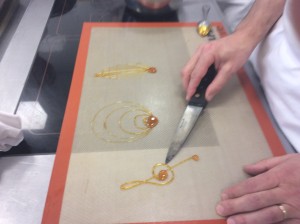
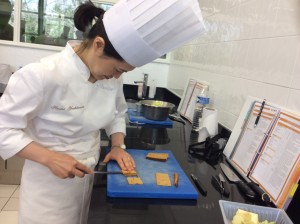
This is Hiromi. One of the great joys of the world is to watch her cut vegetables, particularly little, intricate cuts.. It’s tai chi with a chef’s knife.
Polite & Practically Perfect
I was standing with my friends Hiromi and Elodie at the coffee bar at L’Institut Paul Bocuse on Wednesday, waiting for my “café alllonge” (espresso with some extra water because I considered it ill-advised to belt back another double espresso). Hiromi is a professor of cognitive phycology from Tokyo living here for a year. Elodie has become one of my favorite people. She’s 21 and a native of Lyon. Her parents are from the Auvergne, which is the gloriously earthy region just to the west. Elodie asked, “What do you think of the French people – we don’t know what we are like because we are normal for us.” The question sparked a whole train of thought. What are French people like?
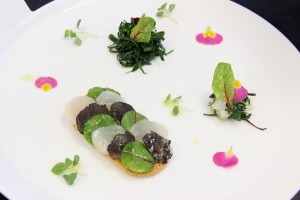
Raw scallop & truffle rounds brushed with vinaigrette on a parmesian sablee, with a little spinach salad in the same lemon vinaigrette. With herbs and primrose petals. This one was all Chef Patrick’s.
I think French people are wonderful. They’re kind, sometimes slightly cynical, funny, relational, very polite & often perfectionistic. This is one of the most visual cultures I’ve encountered. I suspect this orientation toward the visual and exactness is exacerbated for the elite cooks with whom I’m coming into contact.
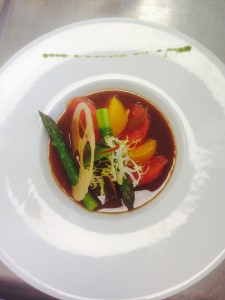
One of the zillion foie gras presentations from last Tuesday. Gosh, does a little of that stuff go a long way with me!
Many, Elodie particularly, are charming and outgoing – demonstrative, fascinated by many things – cooking, design (she’s finishing one program in design and applying to the best industrial design school in France. She doesn’t care WHAT she’s going to design – chairs, cupboards, bicycles, sleeping cubicles, magical animal-people that look like medieval illuminated manuscripts. You ought to see her dossier or projects for school. She has huge eyes and just had 10” of hair cut off, because it was getting “fatiguees” (split ends). I keep finding myself having the feeling I do with Corgi and German Shepherd puppies. I want to take her home – I know that Elizabeth and Sarah would get along with her beautifully. 😀 [There’s a photo of Elodie at the top of my last post]
You say “bonjour” to everyone you pass at school, the clerks in the store, the women at the desk of our “apart-hotel” and the bus driver. You say “bonjour” BEFORE you tell them what you want to buy, or you’re being unutterably rude. You say “bon journee, madam” when you leave (a “have a great day” equivalent). Clerks take an enormous amount of time with everyone – it drives you crazy when you are standing in line. It’s restful and rather self-indulgent when your turn arrives.
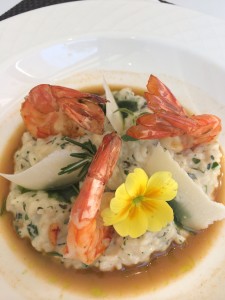
A rather snappy risotto, e4h? Most of them had bright pink flowers. I was the major risotto stirrer. Quite the claim to fame.
I had a 10 minute conversation (no one else in the store, actually) with two women clerks at the pharmacy yesterday. They wanted to know what I was studying at the Institute, where fascinated by the 10-people-from-9 countries-in-my-class thing. They asked about the Paul Bocuse Institute (“Is it a really good school? We don’t know what other people think about it since we’ve always been here.) They were thrilled to know that it was an extraordinarily good school, possibly not as well known outside France as Le Cordon Bleu, but much, much better in the opinion of les connoisseurs. There are three “MOFs” here – “Meillure ouvriers de France,” which translates into “Best French workers” and it’s a huge deal – This wildly rare distinction given to perhaps 20 chefs every three years – the BEST pastry or cheese experts, or cooking chefs in France. There’s a movie about it.
Being a MOF is a huge deal. They wear tri-color collars on their white uniforms for the rest of their lives. One of the pastry chefs won the 2009 competition as the best pastry chef in the world. HIS collar has the flags of all the countries he beat. The competition is being held again this year, in May with the second round in November. My teacher, Patrick Chabassier, is going to compete. 600 chefs enter the competition and by the end of the first day (a long, intense written exam, and random skills tests), 300 chefs are eliminated. In November, semi-finalists have 3 weeks to prepare with the announced lists of ingredients and techniques that they’ll be required to incorporate into a meal). Sounds as if it’s pretty much Nightmare City for the contestants between now and then.

Everybody’s always carving things – diamonds out of potatoes, birds out of zucchini. Pablo, my cooking partner and chef to the princess is great at it and leaves them as presents on my cutting board. THIS one is from the amazing next-door chef, who’s also going to do the MOF competition in May.
One of the MOFs judged a test for the students of the six-week course that’s going on simultaneously with ours. I had a long talk about it last night in the laundry room with the sweetest guy in the world, here from the Ivory Coast. At home everyone loves the food he makes, but yesterday’s test with the MOF was “un catastrophe !” The plate wasn’t hot so the chef rejected it and told him that wasn’t acceptable. There was talk of “…dans la poubelle.” […into the trash.] This kind of thing make students So this sweet man is wonder whether they should try to be chefs. Maybe the dream isn’t reasonable. I told him one of Russ’ favorite bits of advice for me under similar circumstances (the “shake it off, Martha Grace” speech). When I went down to change loads 40 minutes later, he got the call that his wife’s train had broken down and wouldn’t be in until midnight. That was the kind of day it was. Aargh….
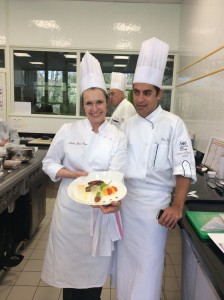
Pablo and me with some foie gras. I may be the only one who doesn’t like pan-fried, highest quality foie gras. We cooked 10 pounds of it in about 437 different ways. (Okay, maybe 12 or 15 ways). There were also 13 lobsters
The clash of cultures with the French chef’ sense of exactness, or perfectionism is painful for the sensitive and the compulsive. The Swiss guy in the six-week course also had a “catastrophe” in yesterday’s test. A week ago Wednesday, I had a Terrible, Horrible, Awful, No-Good-Day, or whatever that Alexander book title was when Elizabeth was little. It involved a cancelled bus, being 5 minutes late, shoes that didn’t fit and launched orthotics out the back like projectiles, a lost hat and some other stuff. Chef stopped class. He slowly left the room to GET me another hat, quietly, with a look, interrupting the entire demonstration on fish. I re-experienced EXACTLY the feeling of mounting tension, panic and guilt when Mom lost the car keys for 15 minutes, wouldn’t let 6-year-old mini-me walk back to school after lunch. I was late and Miss Green, the pencil-thin, 4’9”, pin-curled, box-pleat-skirted, Woodside principal gave me a lecture on not being careless and late. I think that French cooking schools are more restful for people who aren’t wired so tightly – for the guys whose first reaction to a thwap upside the head is, “What? Wha’d I DO?”
But it’s incredibly fun most of the time. It’s fascinating. We are learning cooking techniques that are very subtle, taste profiles and ways of developing so many layers of flavor. One high point was when the chef asked to take some of my blanquette de veau home to his wife because it was exactly right (with the kissing of the finger tips). And if my hyper-sensitive, perfectionistic little feathers get ruffled occasionally. I don’t really care. It’s just too fascinating to take personally.
Food, perfect food – in taste, in visual appeal, is an art form. That’s the message. It’s not to be taken lightly, but with seriousness and with humor. Our future lives will be full of critics. These chefs are here to teach us how to avoid cooking things wrong – to avoid being busted by outsiders. I think that’s close.

a goat cheese. It started round, but that lower left corner was my dinner one night. It was exquisite.
What are the French like? Why am I here? Why did I pick Lyon and this school? What do I think about the French people? They keep asking – the doctor asked me, my French friends wonder, the receptionist at the apart-hotel, the lady at the pharmacy.
So here’s what I think. I think the French people are kind, warm, curiously vulnerable, generous, have the slightly pessimistic outlook – their economy is problematic right now and life is difficult. Many people are quick to laugh and truly relational. Greetings of “bon weekend” and “ca va le weekend?” (“have a great weekend” and “how was your weekend?”) seem heartfelt. They ask and they care. When they say you are kind, you feel kind. Their visual perceptions are quick and incisive (people, style, the knotting of a scarf, the perfect triangle of a quenelle, the 7 sided turned vegetable, the arrangement of glasses and spices, the collar of your raincoat). I’ve heard the saying “you first taste with your eyes,” about 8 times.
So look at the pictures of the food carefully. They’re what the French people are like.
Paul Bocuse 3 week intensive course: Stepping onto a Moving Train.
Woosh, what a first week. I love this place and these people. I’m sitting in my little apartment, eating leftovers from last night’s cheese tasting with a glass of Chateau Neuf de Pape bought at the little grocery store named “Casino” on the corner, thinking specifically of so many of you who may read this. I hope the little piece of Roquefort that was missing from my grubby little wrapped up package of cheese isn’t in the bottom of my new purse mashed between the lining and some metro tickets. Shrugging that thought aside, it has been an amazing week and I’m so glad I’m here.
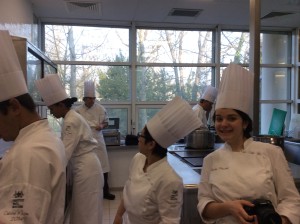
Our class – the smiling little sweetheart looking straight into the camera is Elodie, age 21, our self-appointed guide to Lyon, her city. She’s making it our city, too.
10 of us from 9 countries have hit our kitchen at L”Institut Paul Bocuse at 8:30 a.m. and stir, ciseler, blancher, mincer, gratiner and nettoyer our way toward 5 o’clock. Two nights we’ve had special lectures/tastings (tea and cheese this week). I actually counted the steps of the chateau today and it added up to over 1000 in an average day, 1500 on Monday. Okay, that counts up AND down, but I think that’s fair arithmetic as you run up and down chateau steps, trying to straighten your apron, keep the safety clogs on, and not drop the chef’s hat as it drifts backwards as you simultaneously grab for the railing and smile “bonjour” to the guy in a suit running the staircase in the opposite direction.
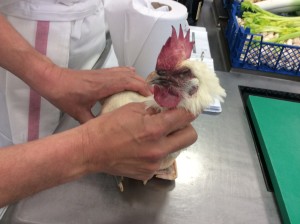
Poulet de Bresse. It really was staggeringly good – truffles under the skin, cooked in a salt/flour/egg white/water coating, then served with a cream, foie gras truffle sauce
Chef Patrick Chabassier’s cooking is mesmerizing. Everything he does with food is quiet. He doesn’t announce demonstrations. He starts doing something. We dash toward him and ask questions to figure out the technique – what is he SEEING that cued him change the heat? What’s he smelling to know it’s time to dump the old butter out of the frogs’ legs and add the butter-herbs-garlic-anise liquor-cumin mixture he had me make? I can’t imagine forgetting the image of this man as he gently juliennes carrots, or reverently rests his hand on the Poulet de Bresse as he explains that this is the best chicken in the world, then smooths its head feathers, pulls at its joints and takes out the neck. He’s quiet. He’s funny. He’s very French, with great kindness and a lovely sense of humor.
He conveys wordlessly a respect for la cuisine Francaise and for us as we’re trying our level best to soak up every insight tired knees will allow overstretched brains to absorb. Today he made the lobsters wave to us. Since it was Friday, we got several renditions of “It’s FRI-day…,” with an ’80’s dance, alternate fingers pointing up. French cooking is hard and French cooking is fun.
Now, for L’Equipe, The Team There are 10 of us from 9 countries (The repeat is Holland, then Luxemburs, Hong Kong, Germany, France, Bulgaria, Uruguay, Japan, and me.) This is one of the nicest and most high powered group of people I’ve met in ages. Our course for obsessive amateurs is 3 packed weeks long and called “Cuisine et Passion.” We do have one professional chef in the group.
Pablo is from Uruguay, where he cooks for a Hapsburg princess. We asked him what he cooks for her and he said in Spanish, “foie gras and things like that.” We nodded understandingly and murmured, “ahhh…. Princess food.” With very different personalities and backgrounds, the group is funny, thoughtful, and kind, with a real feel for food. I haven’t had long conversations with everyone, but may of the stories I’ve heard so far feel familiar – people who have worked hard at professions they love, cooked intensively most of their lives and realize that they want to do once-in-a-lifetime things now, because it matters. Time is precious.
There’s a venture capitalist; an oncological surgeon; a Cisco manager who heads a team that’s working with China; a beautiful Japanese woman whose husband has a sabbatical and who decided to take a year off to be with him; a darling 21 year old from Lyon who’s in cooking school, but spending her spring break here cooking; a German marketing expert who looks like a supermodel, hunts and field dresses deer. (She sent me an e-mail last night with a reminder that although life without creme is possible, it’s utterly meaningless. Anna’s next to the chef in the lobster cutting picture.) The Dutch chief of oncology is to the right. You ought to SEE the way that guy turns mushrooms – small motor coronation like Heifitz’s. Upon mature reflection, that’s probably a VERY good thing.
We’ve worked hard core all week on the French classics – 10 kinds of fish Tuesday, stocks and cutting techniques and vegetables on Monday, Meats (lamb, beef, veal, chicken and rabbit) on Wednesday, probably 15 sauces during the course of the week (you ought to SEE my sabayons and beurre blanc at this point) and all the crustaceans on Friday. Details later, but just enjoy this photo of captains of industry, marketer, doctor, writer, researcher swabbing the decks in the kitchen. Our new hobby, as Paul from Holland said, is washing and IRONING our uniforms. This is a group of people that I suspect don’t typically do a lot of ironing.
Oh, I just found the lost nugget of Roquefort. NOT smashed in the purse. Hurray. Life’s good in Lyon.
First stop: Institut Paul Bocuse, Lyon
Okay. On Friday, in five days, I step onto a plane in St Louis to head to Paris. I arrive in Paris at 6:30 on Saturday and immediately bolt to catch a TGV (the fast train) to Lyon, 2 hours to the southeast. At 12:30 I meet the other 9 students of my three week intensive class for lunch at the school’s restaurant on the Place Bellecour, Lyon’s main square, on Presque Ile (“almost island” – the peninsula between the Saone and Rhone rivers. Lyon is called France’s Gastronomic Capital. It is the home of Paul Bocuse, one of the developers of Nouvelle Cuisine in the 60’s. The great annual cooking award in France is the Paul Bocuse Award.
The class list arrived last week. There are 10 students. I’m the only native English speaker and there’s only one nationality repeat – two men from Holland. Malaysia, Germany, France, Luxembourg, Bulgaria, Uruguay and Japan. Half men, half women. Why do I feel as if I’m heading off to my junior year in Madrid, where I threw everything into a suitcase the night before and boarded a plane for a continent where I knew not a soul?
At least they issue us a set of knives, the hat and seven league cooking boots. This must be last year’s class:
Et si la cuisine traditionnelle était un tremplin vers la cuisine contemporaine ? Au-delà d’une initiation aux fondamentaux de la cuisine, ce programme intensif de 3 semaines vous emmène à la découverte de techniques culinaires et des tendances gastronomiques les plus actuelles.
You get that? Standing at the top of the luge run, shaking off the tension… this is exciting. Next post from the other side.




